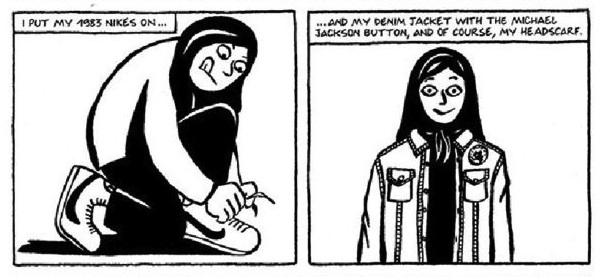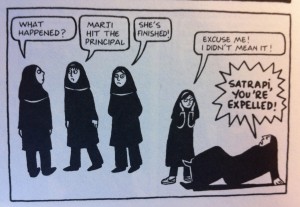For the past two weeks in ASTU class, we have been studying Marjane Satrapi’s Persepolis, which is a graphic novel about Satrapi’s growing up in the Iranian Revolution. Inspired by the discussion in our recent sociology lectures about cultures, and in particular material culture, which is the physical evidence and objects that belong to a specific culture (Ritzer and Guppy, 120), I wanted to explore the presentation of material culture and cultural contrasts in Persepolis.
I found that in Persepolis, the veil is one of the most prominent objects that represents the Iranian culture. In the 1980s, the leaders of the Islamic revolution made it mandatory for all women to wear a veil (Satrapi, 3). The opening frames of the novel, which portrays a group of girls who are covered in veil, immediately depicts the importance of the veil in revolutionary Iran. The veil becomes a part of the social values and norms, and shows the political ideology in Iran. However, for Satrapi, the veil symbolizes something different, and they could be repression, a loss of identity, and a possible need for a revolution.

The western culture is also presented in Persepolis through materials such as rock band posters in Satrapi’s room and Satrapi’s clothing. Satrapi also visits ‘black markets’, where people sell western commodities like audiotapes (Satrapi, 131-2). The presentation of Western culture shows the how influential cultures can be. It allows Satrapi to really show her personal identity, which is the western political and social beliefs she and her family holds.
How does Satrapi adapt to the two contrasting cultures? In this scene, Satrapi embraces both cultures. She wears her denim jacket with a Michael Jackson button and Nike, and says ‘of course, my headscarf’. This displays Satrapi’s multiple personal identities: following middle eastern customs while sharing western values.

The clash of western and middle eastern culture, however, also serves as a catalyst to Satrapi’s rebellion. As a child, Satrapi often refuses to follow customs and school rules. This is shown in the beginning of the last chapter of the book: ‘The Dowry’, in which the school principal tries to take Satrapi’s jewelry away, Satrapi accidentally pushes the principle to the floor, and the principle expels her. This scene is significant because it shows how Satrapi assures her personal identity by rebelling against traditions and rules.
As mentioned in my previous blog post, understanding cultures allows readers to read life narratives more carefully and critically. The cultural differences in Persepolis is powerful in showing Satrapi’s personal identities and thoughts, which makes the novel engaging. I am interested in knowing about your opinions on how culture is presented in Persepolis, or in other forms of life narratives. Leave your thoughts in the comment section below!
—-
Work cited:
Ritzer, George, and Neil Guppy. “Cultures.” Introduction to sociology. Canadian version. ed. London: SAGE, 2013. 120. Print.
Satrapi, Marjane. Persepolis. New York, NY: Pantheon Books, 2003. Print.
“Meanings of the Veil: Representations of Veiling in Persepolis.” Serendip Studio. mpottash., 13 Nov. 2008. Web. 18 Oct. 2014. <http://serendip.brynmawr.edu/exchange/node/3331>
Tinmanee, Elle. “Chapter 17: “Kim Wilde” by Elle Tinmanee.” Persepolis. N.p., 22 Mar. 2013. Web. 21 Oct. 2014. <http://ibpersepolis.wordpress.com/2013/03/22/chapter-17-kim-wilde-by-elle-tinmanee/>.

Hi Natalie!
I really like your post here about the representation of culture in Persepolis. For me, I am particularly interested in how the drawings of Persepolis resemble ancient Iranian art (http://si.wsj.net/public/resources/images/PT-AM103_MPshah_G_20090721113842.jpg). More explicitly, as you can see through the link, there are panels in the text describing the history of Iran which use the same pattern of illustration (page 11). I observe that Persepolis conveys a rather liberal, modern mindset of Satrapi, yet the work delicately implements certain artistic values of the national art in the visualization process. The hybridity that is accordant to your observation of two contrasting culture of the West and Islam.
You’re a liar. You didn’t cite 2 of your 4 sources in your blog. You have plagarized.
You cant call him a liar. You’re a liar SIR.
hey there
ok boomer
hi
1v1 me in cod mw bro Ill literally fuck your shit up
Add me nutngo24
annoying
Where are your others sources referenced? This is plagiarism. Ridiculous.
Ur gey
oh hey there, you think your better than me?-luke
fuck nya i hate black people-aiders
sorry someone has been hacking my computer, this statement is not acceptable and I strongly apologize for this persons actions
Can the Administrator of this blog please take this comment down? I did not say this and it is unacceptable.
wut is rong wit u
rrgrg
I love this book
wtf is going on
I hat e the nigga
this comment section is whack
yall racist
sikicem seni
jesus yall good
just jump…
I also try to learn spinfile-languages.dat in my free time.
|
I really like spinfile-tvseries.dat!
Hello from columnspinfile-address_data.dat-1. I’m glad to came here. My first name is spinfile-names.dat.
My name is spinfile-names.dat and I’m a random-17-30 years old girl from columnspinfile-address_data.dat-1.
Keep ma name out yo mouth
Yooo, fuck dis shit, was going on here. This so bullshit and imma make it right. Im making a new movie if yall wanna be background actors, just lemme know and ill get u in a spot. Peace out niggas
I wanna be in it!
Count me insies!!!
Ayo dont forget me cuh, im a black parasite on ur back, lemme suck
Pipe down lil nigga
im back from the grave bitch, getcho raggady ass back into bed
I thought u was dead cuh
shut yo mouth g, take this D
Da Baby ur a floppp
shut the frick up fred, ur the worst player In my team at soccer, absolutely shit
hey hey hey shushhhhhh
This is a private conversation and does not include you. This is purely between myself, Mr. Fredrick Brown and Winnie. Please stop trying to include yourself to feel important.
Kindest of regards,
Fred Brown,
Former captain of Chinese and Fencing at the Toowoomba Grammar School and current assistant to the lead botanist at the University of Southern Queensland